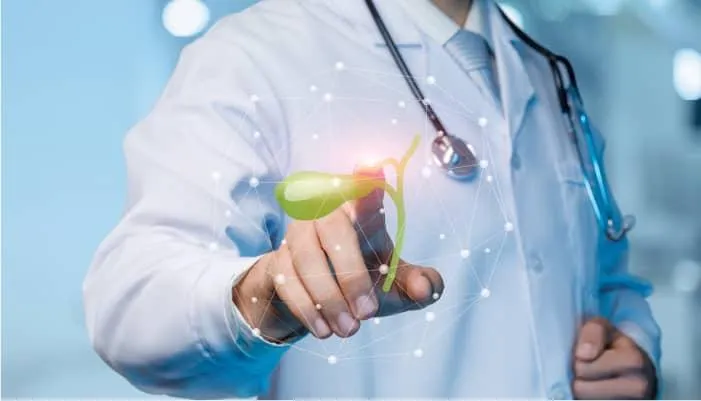Health Problems Associated with the Gallbladder
November 14, 2022
What is the gallbladder?
It is a little organ with a pear shape. The gallbladder is in your abdomen's upper right corner (belly). It is directly underneath your liver. Bile is both stored and released. Your liver produces bile, a fluid that aids the digestion of dietary lipids. Your digestive system includes your gallbladder. The storage of bile is its primary purpose. Your digestive system breaks down lipids with the aid of bile. The three primary components of bile are cholesterol, bilirubin, and bile salts.
Problems Associated with the Gallbladder
There are many problems associated with the gallbladder. Here are some of them-
Gall stones
Gallstones are bile-containing pebble-like particles that can form in the gallbladder or bile ducts. They range in size from the size of golf balls to small sand grains. Though they usually don't injure anyone
Causes-
-
Extra bilirubin: Most gallstones are composed of excess bilirubin. The result of your liver's breakdown of red blood cells is bilirubin.
-
Gallbladder stasis: When your small intestine needs to break down fats, it tells your gallbladder to send bile. When your gallbladder functions normally, it contracts to push bile out as effectively required. However, some bitterness may remain if your gallbladder doesn't constrict sufficiently. At the base of your gallbladder, this bile eventually condenses into a sort of sludge that crystallizes.
Symptoms -
Symptoms may include -
-
Sharp pain in the upper right stomach region that gradually increases.
-
Fever, along with chills.
-
Increase in heart rate.
Treatment
Most gallstone sufferers won't ever require medical attention. However, if your gallstones become problematic, your doctor may recommend having them removed. Even if only one of your gallstones is now giving you problems, they will often want to remove all of them. A blockage is likely to recur if it occurs once. Waiting around is not worth the danger. The recommended course of therapy for troublesome gallstones is complete gallbladder removal because there is no way to access the gallstones inside your gallbladder.
Cholecystitis
The gallbladder will be inflamed in case of cholecystitis. Inflammation usually refers to swelling. For example, it could occur if a gallstone prevents bile from leaving your gallbladder. Cholecystitis typically requires surgery and results in fever and discomfort.
Causes
It often develops when bile becomes blocked in your gallbladder and picks up a bacterial infection. For example, bile becomes stuck when gallstones obstruct the bile's exit from your gallbladder. Less frequent reasons include tumours that impede the passage of bile from your gallbladder, diminished blood supply to your gallbladder, clogged bile ducts caused by scarring and viral infections that cause inflammation.
Symptoms -
There are two types of cholecystitis, based on which the symptoms vary-
-
Acute cholecystitis develops rapidly and is quite painful. Gallstones are present in more than 95% of patients with acute cholecystitis. The mid to upper right abdomen is where the pain starts, but it can also radiate to the back. After eating, the pain lingers but is at its worst for 15 to 20 minutes. A medical emergency is one in which pain is still intense.
-
Recurrent outbreaks of pain and inflammation are more common in chronic cholecystitis. Compared to acute cholecystitis, pain is typically less intense and less prolonged. Gallstones, often intermittently obstructing the cystic duct, usually cause recurrent episodes.
Treatment
Based on the severity of the disease, the treatment plan is decided -
-
Regulating diet and fasting help to calm the gallbladder.
-
Analgesics are given for pain management.
-
To help with dehydration, IV fluids are administered.
-
Antibiotics are administered to fight against bacterial and viral infections.
-
The gallbladder is removed. The procedure, known as a cholecystectomy, is often carried out by inserting a laparoscope (a tiny camera) through small abdominal incisions to view the belly and surgical tools to remove the gallbladder. The gallbladder is often removed within 24 to 48 hours of admission in acute cholecystitis.
Gallstone pancreatitis
There shall be severe inflammation in case of gallstone pancreatitis. It happens when a gallstone moves through the common bile duct and obstructs a portion of the pancreatic duct right before it empties into the small intestine.
Causes
The common bile duct joins your pancreas and gallbladder together. Bile travels from your gallbladder to the small intestine via the common bile duct. One of the gallstones, however, could also pass through if you have any.
When they are little, gallstones can move but enlarge when new bile passes over them over time. Once moving, a gallstone may eventually become impaled in a confined space. A gallstone may obstruct the pancreatic duct by entering it or may result in an obstruction outside of it.
Symptoms
Symptoms may vary from severe pain, nausea, vomiting, and fever. In addition, it depends on the degree of inflammation.
Treatment
-
IV liquids- Most people need to rehydrate and increase their blood volume. An intravenous catheter will be inserted into a vein in your arm or hand by a medical team member to administer continuous fluids, including electrolytes.
-
Pain reduction- Most individuals will require effective pain treatment, which they can get either by an IV or an injection.
-
Stomach rest- You'll likely have to put food away until your pancreas settles down. Your pancreas is notified when your digestive system is active, which causes it to produce more enzymes and bile from your liver and gallbladder. This worsens your disease by increasing the pressure inside your bile ducts.
-
Nutritional assistance- They may add some glucose to the fluids in your IV to give you energy, or they may provide you with sustenance via a nasogastric tube or an IV.
Conclusion
If you are experiencing sharp shooting pain in the upper right region of your stomach, it might be related to the gall bladder. Also, if you have any other symptoms, such as fever, nausea, and vomiting, it is time to get your checkup done.
Dr Sanjeev Kumar
MBBS,MD...
| Experience | : | 17 Years |
|---|---|---|
| Speciality | : | Gastroenterology |
| Location | : | Patna-Agam Kuan |
| Timings | : | Mon - Sat : 03:00 PM to 09:00 PM |
Dr Vijay Prakash
MD,DNB,MRCP...
| Experience | : | 30 Years |
|---|---|---|
| Speciality | : | Gastroenterology |
| Location | : | Patna-Agam Kuan |
| Timings | : | Mon - Sat : 09:00 AM to 03:00 PM |
Dr Deepak
MD,DNB...
| Experience | : | 7 Years |
|---|---|---|
| Speciality | : | Gastroenterology |
| Location | : | Patna-Agam Kuan |
| Timings | : | Mon - Sat : 11:00 AM to 06:00 PM |
Dr. Aditya Shah
MBBS, MD, DM (Gastroenterology)...
| Experience | : | 5 Years |
|---|---|---|
| Speciality | : | Gastroenterology |
| Location | : | Chennai-MRC Nagar |
| Timings | : | Tue, Thu & Sat : 06:00 PM to 07:00 PM |
Dr. M Barath Kumar
MBBS, MD (INT.MED), DNB (GASTRO), MRCP (UK), MRCP (EDIN)...
| Experience | : | 12 Years |
|---|---|---|
| Speciality | : | Gastroenterology |
| Location | : | Chennai-Alwarpet |
| Timings | : | Mon to Sat : 06:30 PM – 07:30 PM |
Dr. Ashwin Kumar Myneni
MBBS, MS, DNB...
| Experience | : | 12 Years |
|---|---|---|
| Speciality | : | Gastroenterology |
| Location | : | Hyderabad-Kondapur |
| Timings | : | Mon, Wed, Sat : 07:30 PM to 08:30 PM |
Fever is a common sign of infection in the body. It can also be caused due to gall bladder infection.
Glucose is commonly administered along with nutrients in case of gall bladder infection. This way the body gets the required nutrition, while giving rest to the stomach.
NOTICE BOARD
CONTACT US
CONTACT US
 Book Appointment
Book Appointment








.svg)
.svg)
.svg)
.svg)








